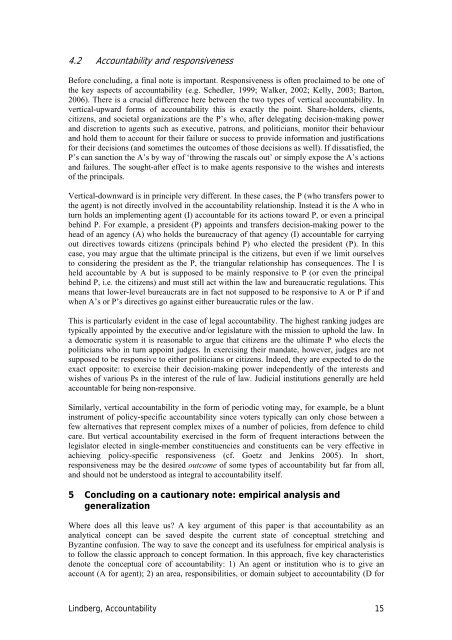Accountability
Accountability
Accountability
Create successful ePaper yourself
Turn your PDF publications into a flip-book with our unique Google optimized e-Paper software.
4.2 <strong>Accountability</strong> and responsiveness<br />
Before concluding, a final note is important. Responsiveness is often proclaimed to be one of<br />
the key aspects of accountability (e.g. Schedler, 1999; Walker, 2002; Kelly, 2003; Barton,<br />
2006). There is a crucial difference here between the two types of vertical accountability. In<br />
vertical-upward forms of accountability this is exactly the point. Share-holders, clients,<br />
citizens, and societal organizations are the P’s who, after delegating decision-making power<br />
and discretion to agents such as executive, patrons, and politicians, monitor their behaviour<br />
and hold them to account for their failure or success to provide information and justifications<br />
for their decisions (and sometimes the outcomes of those decisions as well). If dissatisfied, the<br />
P’s can sanction the A’s by way of ‘throwing the rascals out’ or simply expose the A’s actions<br />
and failures. The sought-after effect is to make agents responsive to the wishes and interests<br />
of the principals.<br />
Vertical-downward is in principle very different. In these cases, the P (who transfers power to<br />
the agent) is not directly involved in the accountability relationship. Instead it is the A who in<br />
turn holds an implementing agent (I) accountable for its actions toward P, or even a principal<br />
behind P. For example, a president (P) appoints and transfers decision-making power to the<br />
head of an agency (A) who holds the bureaucracy of that agency (I) accountable for carrying<br />
out directives towards citizens (principals behind P) who elected the president (P). In this<br />
case, you may argue that the ultimate principal is the citizens, but even if we limit ourselves<br />
to considering the president as the P, the triangular relationship has consequences. The I is<br />
held accountable by A but is supposed to be mainly responsive to P (or even the principal<br />
behind P, i.e. the citizens) and must still act within the law and bureaucratic regulations. This<br />
means that lower-level bureaucrats are in fact not supposed to be responsive to A or P if and<br />
when A’s or P’s directives go against either bureaucratic rules or the law.<br />
This is particularly evident in the case of legal accountability. The highest ranking judges are<br />
typically appointed by the executive and/or legislature with the mission to uphold the law. In<br />
a democratic system it is reasonable to argue that citizens are the ultimate P who elects the<br />
politicians who in turn appoint judges. In exercising their mandate, however, judges are not<br />
supposed to be responsive to either politicians or citizens. Indeed, they are expected to do the<br />
exact opposite: to exercise their decision-making power independently of the interests and<br />
wishes of various Ps in the interest of the rule of law. Judicial institutions generally are held<br />
accountable for being non-responsive.<br />
Similarly, vertical accountability in the form of periodic voting may, for example, be a blunt<br />
instrument of policy-specific accountability since voters typically can only chose between a<br />
few alternatives that represent complex mixes of a number of policies, from defence to child<br />
care. But vertical accountability exercised in the form of frequent interactions between the<br />
legislator elected in single-member constituencies and constituents can be very effective in<br />
achieving policy-specific responsiveness (cf. Goetz and Jenkins 2005). In short,<br />
responsiveness may be the desired outcome of some types of accountability but far from all,<br />
and should not be understood as integral to accountability itself.<br />
5 Concluding on a cautionary note: empirical analysis and<br />
generalization<br />
Where does all this leave us? A key argument of this paper is that accountability as an<br />
analytical concept can be saved despite the current state of conceptual stretching and<br />
Byzantine confusion. The way to save the concept and its usefulness for empirical analysis is<br />
to follow the classic approach to concept formation. In this approach, five key characteristics<br />
denote the conceptual core of accountability: 1) An agent or institution who is to give an<br />
account (A for agent); 2) an area, responsibilities, or domain subject to accountability (D for<br />
Lindberg, <strong>Accountability</strong> 15

















